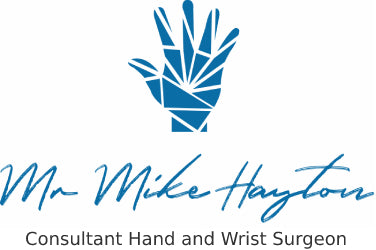Scapho Lunate Ligament
The scapho-lunate ligament rupture is the commonest ligament injury in the wrist. It connects the scaphoid and lunate bones together and stops them from being prised apart. If left untreated the wrist can deteriorate and become arthritic over the following 5-10 years. This is the so-called SLAC wrist (Scapho-Lunate-Advanced-Collapse).
The mechanism of injury is often a fall onto an outstretched hand and wrist.
Pain is well localised to the back of the wrist centrally. Patients often lose wrist extension (cock wrist back). Occasionally they will notice clunking and a feeling of giving way of the wrist.
Plain x-rays may show a gap between the scaphoid and lunate on the AP (front on) view. On the lateral (side on) x-ray view sometimes the lunate bone may be falling backwards called a DISI deformity (Dorsal Intercalated Segment Instability). In the x-ray below right the red arrow shows an increased gap between the scaphoid and lunate.

Occasionally, the x-rays can be normal and stress grip views may show an abnormality and this is described as a dynamic X-ray.
MRI scans show the bones and their attached ligaments, the angles of the bones can be measured in respect of each other to help make the diagnosis. An MRI arthrogram involves initially injecting dye into the wrist under x-ray control and then an MRI performed. The MRI can see where the dye has tracked and any abnormal areas of dye collection can help identify the injuries sustained. Modern 3T scanners now do not often need an arthrogram and this has largely been abandoned in Mike's practice relying on plain MRI and careful clinical assesment.
A wrist arthroscopy is considered by many to be the gold standard to diagnose scapho-lunate ligament injuries. Using small incisions a camera is introduced into the wrist to visualise the bones, any gaps or abnormal movement and view the membranous part of the scapho-lunate ligament.
It is important to establish if the scapho-ulnate ligament injury is acute ( < 6 weeks ) or more chronic (>12 weeks).
Early ligament injuries (<6 weeks) will have healing potential and amenable to acute repair. More chronic injuries (>12 weeks) will result in the ligament losing its healing potential in which case a ligament reconstruction may be more appropriate.
Between 6-12 weeks there is a gradual deterioration in healing potential.
There are different surgical procedures for repairing scapholunate ligament injuries, and the choice of procedure depends on the severity and nature of the ligament damage. Common surgical techniques include:
- Scapholunate Ligament Repair: In cases where the ligament is partially torn or stretched, a surgeon may choose to repair the ligament. This can involve suturing the ligament back together using anchors to reattach it to the bone and supporting it with temporary K wires.
- Scapholunate Ligament Reconstruction: In cases of chronic ligament tears reconstruction may be necessary. This typically involves using a locally harvested tendon graft to create a new ligament that is attached to the bones with anchors.
Recovery after scapho-lunate ligament surgery varies depending on the procedure performed and the individual patient. Hand therapy is often a crucial component of rehabilitation to restore strength and range of motion.
I have published my results on scapho-ulnate ligament reconstructions in the general populations and also in elite athletes withe excellent results.
85% of athletes returned to the same level of sport on average at 4 months post surgery.
It is important for individuals considering surgery to have a thorough discussion with their orthopedic surgeon. The decision to undergo surgery should be based on a careful assessment of the specific injury, the individual's overall health, and the expected benefits and risks of the procedure. As with any surgical procedure, there are potential complications, and outcomes can vary from person to person.
